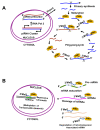Small Non-Coding-RNA in Gynecological Malignancies
- PMID: 33802524
- PMCID: PMC7961667
- DOI: 10.3390/cancers13051085
Small Non-Coding-RNA in Gynecological Malignancies
Abstract
Gynecologic malignancies, which include cancers of the cervix, ovary, uterus, vulva, vagina, and fallopian tube, are among the leading causes of female mortality worldwide, with the most prevalent being endometrial, ovarian, and cervical cancer. Gynecologic malignancies are complex, heterogeneous diseases, and despite extensive research efforts, the molecular mechanisms underlying their development and pathology remain largely unclear. Currently, mechanistic and therapeutic research in cancer is largely focused on protein targets that are encoded by about 1% of the human genome. Our current understanding of 99% of the genome, which includes noncoding RNA, is limited. The discovery of tens of thousands of noncoding RNAs (ncRNAs), possessing either structural or regulatory functions, has fundamentally altered our understanding of genetics, physiology, pathophysiology, and disease treatment as they relate to gynecologic malignancies. In recent years, it has become clear that ncRNAs are relatively stable, and can serve as biomarkers for cancer diagnosis and prognosis, as well as guide therapy choices. Here we discuss the role of small non-coding RNAs, i.e., microRNAs (miRs), P-Element induced wimpy testis interacting (PIWI) RNAs (piRNAs), and tRNA-derived small RNAs in gynecological malignancies, specifically focusing on ovarian, endometrial, and cervical cancer.
Keywords: P-Element induced wimpy testis interacting (PIWI) RNAs (piRNAs); cervical cancer; endometrial cancer; gynecological malignancies; microRNAs (miRs); ovarian cancer; small non-coding-RNA; tRNA-derived small RNAs.
Conflict of interest statement
Authors declare no conflict of interest.
Figures









Similar articles
-
Depressing time: Waiting, melancholia, and the psychoanalytic practice of care.In: Kirtsoglou E, Simpson B, editors. The Time of Anthropology: Studies of Contemporary Chronopolitics. Abingdon: Routledge; 2020. Chapter 5. In: Kirtsoglou E, Simpson B, editors. The Time of Anthropology: Studies of Contemporary Chronopolitics. Abingdon: Routledge; 2020. Chapter 5. PMID: 36137063 Free Books & Documents. Review.
-
Small non-coding RNAs as diagnostic, prognostic and predictive biomarkers of gynecological cancers: an update.Expert Rev Mol Diagn. 2024 Nov;24(11):979-995. doi: 10.1080/14737159.2024.2408740. Epub 2024 Oct 10. Expert Rev Mol Diagn. 2024. PMID: 39390687 Review.
-
Impact of residual disease as a prognostic factor for survival in women with advanced epithelial ovarian cancer after primary surgery.Cochrane Database Syst Rev. 2022 Sep 26;9(9):CD015048. doi: 10.1002/14651858.CD015048.pub2. Cochrane Database Syst Rev. 2022. PMID: 36161421 Free PMC article. Review.
-
The effectiveness of school-based family asthma educational programs on the quality of life and number of asthma exacerbations of children aged five to 18 years diagnosed with asthma: a systematic review protocol.JBI Database System Rev Implement Rep. 2015 Oct;13(10):69-81. doi: 10.11124/jbisrir-2015-2335. JBI Database System Rev Implement Rep. 2015. PMID: 26571284
-
Using Experience Sampling Methodology to Capture Disclosure Opportunities for Autistic Adults.Autism Adulthood. 2023 Dec 1;5(4):389-400. doi: 10.1089/aut.2022.0090. Epub 2023 Dec 12. Autism Adulthood. 2023. PMID: 38116059 Free PMC article.
Cited by
-
Towards Personalized Medicine: Non-Coding RNAs and Endometrial Cancer.Healthcare (Basel). 2021 Jul 30;9(8):965. doi: 10.3390/healthcare9080965. Healthcare (Basel). 2021. PMID: 34442102 Free PMC article. Review.
-
Future Screening Prospects for Ovarian Cancer.Cancers (Basel). 2021 Jul 30;13(15):3840. doi: 10.3390/cancers13153840. Cancers (Basel). 2021. PMID: 34359740 Free PMC article. Review.
-
Strategy for Pre-Clinical Development of Active Targeting MicroRNA Oligonucleotide Therapeutics for Unmet Medical Needs.Int J Mol Sci. 2023 Apr 12;24(8):7126. doi: 10.3390/ijms24087126. Int J Mol Sci. 2023. PMID: 37108289 Free PMC article.
-
Small Noncoding RNAs in Reproduction and Infertility.Biomedicines. 2021 Dec 12;9(12):1884. doi: 10.3390/biomedicines9121884. Biomedicines. 2021. PMID: 34944700 Free PMC article. Review.
-
Circulating Hsa-miR-431-5p as Potential Biomarker for Squamous Cell Vulvar Carcinoma and Its Premalignant Lesions.Diagnostics (Basel). 2021 Sep 17;11(9):1706. doi: 10.3390/diagnostics11091706. Diagnostics (Basel). 2021. PMID: 34574047 Free PMC article.
References
-
- Tsikouras P., Zervoudis S., Manav B., Tomara E., Iatrakis G., Romanidis C., Bothou A., Galazios G. Cervical cancer: Screening, diagnosis and staging. J. BUON. 2016;21:320–325. - PubMed
Publication types
Grants and funding
LinkOut - more resources
Full Text Sources
Other Literature Sources

